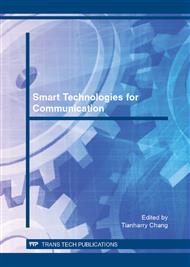[1]
Hajo A. Reijers, Minseok Song, Heidi Romero, et al.: A Collaboration and Productiveness Analysis of the BPM Community, in: 7th International Conference on Business Process Management, , edited by D. Umeshwar, E. Johann, pp.1-14, Springer (2009).
DOI: 10.1007/978-3-642-03848-8_1
Google Scholar
[2]
Object Management Group: DTC/2008-01-17 Business Process Modeling Notation (OMG, USA, 2008).
Google Scholar
[3]
Workflow Management Coalition: WFMC-TC-1025 Process Definition Interface – XML Process Definition Language (WfMC, USA, 2008).
Google Scholar
[4]
TIBCO: TIBCO Business Studio", http: /developer. tibco. com/business_studio.
Google Scholar
[5]
Microsoft: Windows Workflow Foundation, http: /www. microsoft. com/visualstudio/en-us/products/ 2010-editions.
Google Scholar
[6]
S. Sendall, W. Kozaczynski: Model transformation: The heart and soul of model-driven software development, IEEE Software vol. 20 (2003), pp.42-45.
DOI: 10.1109/ms.2003.1231150
Google Scholar
[7]
Weqqing Lin, Jian Wang: Analysis of process control pattern of XPDL 2. 0, Jisuanji Jicheng Zhizao Xitong/Computer Integrated Manufacturing Systems, vol. 13 (2007), pp.1839-1846.
Google Scholar
[8]
M. Zapletal, W.M.P. Aalst, N. Russell, et al: An Analysis of Windows Workflow's Control-Flow Expressiveness, in: Proceedings of the 7th IEEE European Conference on Web Services, edited by R. Eshuis, P. Grefen, pp.200-209, IEEE Computer Society (2009).
DOI: 10.1109/ecows.2009.17
Google Scholar
[9]
Lin Miao, Tao Jin, Jianmin Wang: Transformation Technology from XPDL Model to WWF Model, Jisuanji Yanjiu yu Fazhan/Computer Research and Development, suppl. 46 (2009), pp.165-171.
Google Scholar
[10]
Jian Deng, Zhi Chen, Jiazhi Zeng: Formal verification of business process models using Petri nets, Jisuanji Jicheng Zhizao Xitong/Computer Integrated Manufacturing Systems, vol. 17 (2011), pp.1110-1119.
Google Scholar
[11]
Jian Deng, Zhi Chen, Jiazhi Zeng: A method to check the structure of sequential business process models, in: 2011 International Conference on Automation and Robotic (ICAR 2011), edited by L. Gary, pp.363-371, Springer (2011).
DOI: 10.1007/978-3-642-25646-2_48
Google Scholar
[12]
B. Bruce: Pro WF: Windows Workflow in . NET 4 (Apress, USA, 2010).
Google Scholar


